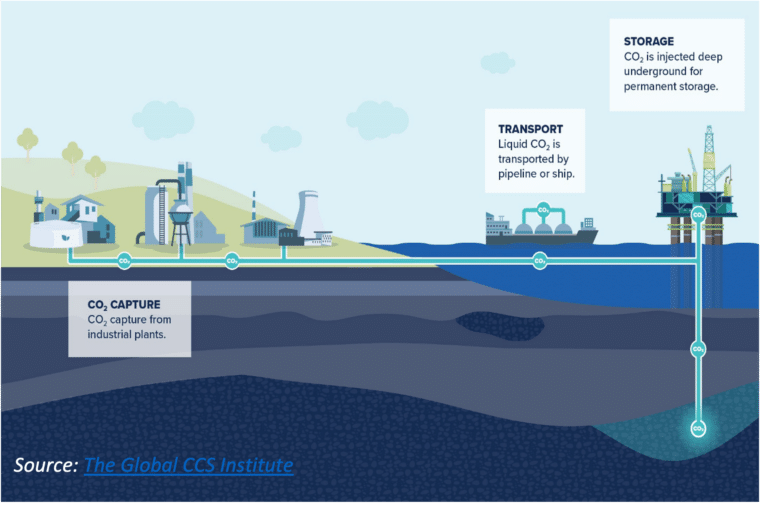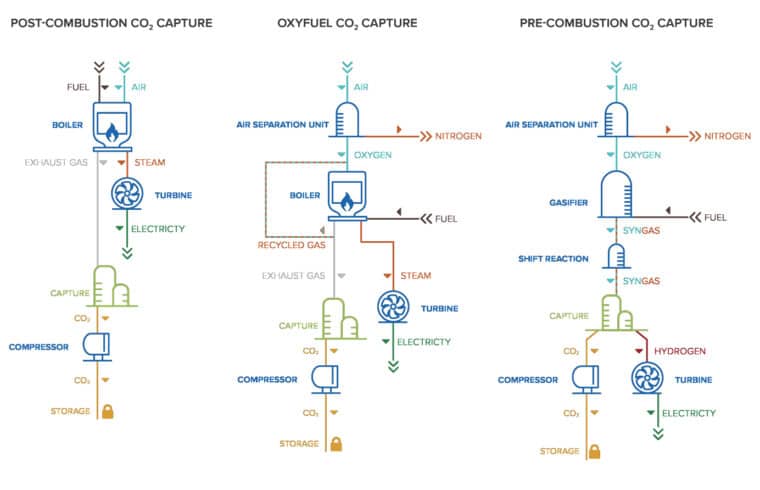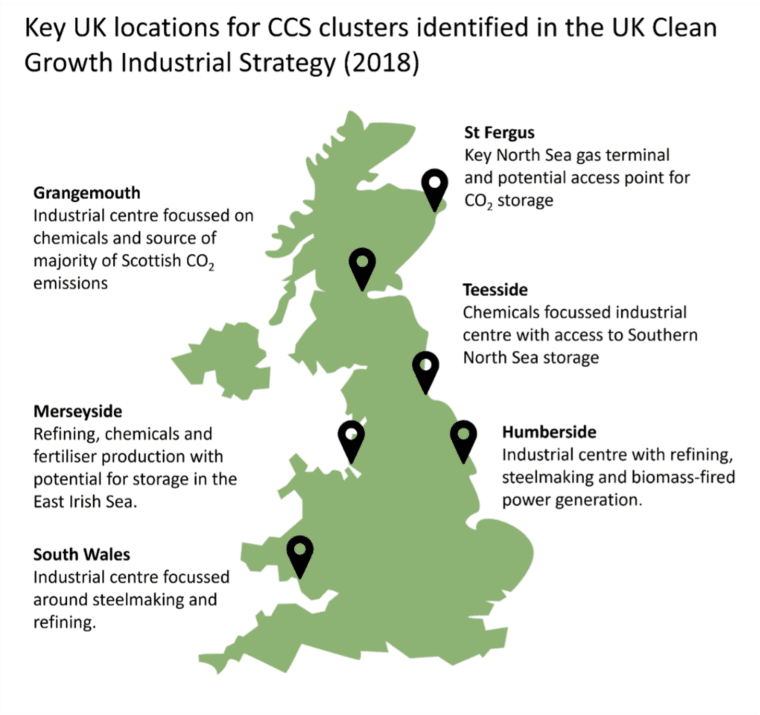Bioenergy with Carbon Capture and Storage (BECCS)
Key messages:
- Bioenergy with carbon capture and storage (BECCS) involves generating heat and power from biomass fuels, capturing the emissions released and storing them.
- BECCS represents one of only a few technological options currently available to remove historic CO2 emissions from the atmosphere.
- The UK government has stated that future large-scale biomass power facilities will not be supported without the inclusion of CCS.
- To achieve net-negative emissions reduction via BECCS, significant quantities of land will be required to grow dedicated energy crops. This must be managed sustainably to prevent negative impacts on biodiversity and competition with food production.
Introduction
Bioenergy from plant biomass coupled with carbon capture and storage (BECCS), is regarded by the UK government as one of the key greenhouse gas removal (GGR) mechanisms currently available to avoid global warming passing beyond 1.5°C. BECCS involves using plant biomass to remove historic CO2 emissions from the atmosphere, generate power, and subsequently capture the carbon emissions released and store them long-term. The UK Climate Change Committee have estimated BECCS could sequester between 20 – 65 Mt CO2 equivalent per year by 2050, equivalent to 15% of the current UK CO2 emissions.
What are Carbon Capture and Storage technologies?
The overall purpose of carbon capture utilisation and storage (CCUS) is to stop carbon dioxide (CO2) emissions from combustion reaching the atmosphere and adding to global warming. Instead, the CO2 produced is captured at source and is either utilised in another industrial process (CCU) or stored deep underground in geological formations (CCS).
The British geological survey has described CCS as ‘the oil extraction industry in reverse’: replacing natural gas and oil removed from the earth with CO2 produced from the combustion of it. The process is already in use in existing oil recovery operations where it used by oil companies to extract more oil from existing wells.
While use of CCUS to capture CO2 released from the burning of fossil fuels would undoubtedly help reduce future emissions, it does nothing to help reduce the levels of CO2 that have already been released into the atmosphere and already driving climate change. While other ‘direct-air’ carbon capture (DAC) technologies are also being developed, BECCS has the potential to be deployed more swiftly because it utilises the existing biology of plants to capture historic CO2 from the atmosphere and store it. The technology this requires can be retrofitted to many existing facilities. This provides options for decarbonising industries that are already emitting significant quantities of CO2, such as power stations, cement production and steel manufacture. If sufficient plant material can be grown, harvested and transported sustainably, BECCS could offer a viable means of reducing global carbon emissions.
How does BECCS work?
While plants are actively growing, they are removing CO2 from the atmosphere and storing it in their bodies – essentially nature’s own version of carbon capture and storage. Plants capture CO2 from the atmosphere during photosynthesis; where CO2 combined with energy from the sun, water and nutrients from the soil, is converted into biomass that is used to build their above and below-ground structures. When the plant dies and rots or is burned, most of the CO2 captured during its lifetime is released back into the atmosphere. However, if the carbon emitted from burning biomass is captured and stored long-term, the process potentially becomes ‘carbon-negative’. Put simply, the BECCS process involves carbon being actively removed from the atmosphere by plants to produce a biomass fuel, that fuel is used to generate heat and power, and the emissions produced in the process are captured and stored.
How is the carbon captured?
There are three main methods of carbon capture:
- Post-combustion – Capturing GHGs as they exit the flue after combustion.
- Oxyfuel combustion – Combustion of fuel in an excess of oxygen so it is completely converted to a mixture of CO2 and steam.
- Pre-combustion – Converting fuel to a hydrocarbon gas (gasification) and removing CO2 formed during the process prior to combustion.
Post-combustion and Oxyfuel combustion are most applicable for use by existing power and heat generators as it is possible to retrofit these systems. Pre-combustion processes are more applicable to gasification processes which can be used for heat and power but also for generation of liquid transport or aviation fuels. In this instance the process captures CO2 released during the gasification step of the process, but CO2 will still be released when the hydrocarbon fuel produced is subsequently burned.
The gasses that are captured during this process undergo a process called ‘scrubbing’ where they are passed/bubbled through a solvent media which causes particulates in the gas stream to be removed and the pure CO2 is separated, pressurised to a liquid state, and can then be bottled, piped or transported in the same way as other commercially used gasses. Once in a clean, transportable state the CO2 can either be:
- Utilised (CCU) for other industrial processes: manufacturing, generation of hydrogen or use in plant or aquaculture growth chambers.
- Stored (CCS) by pumping the CO2 into suitable geological formations (>1km) deep below the land or sea.
A comprehensive review of the BECCS processes has been written by Shahbaz et al. (2021).
Where is BECCS currently being used?
Carbon Capture Utilisation and Storage (CCUS) technologies are already being developed in many parts of the world. According to a recent report by the International Energy Agency (IEA), in September 2022, there were 35 commercial facilities in operation collectively capturing approximately 45 Mt CO2 globally, with many more either planned or under development. CCUS is also one of the main elements of the UK governments Clean Growth industrial strategy. According to the IEA, globally over 2 Mt CO2 are currently being captured annually from biogenic (biomass derived) sources, half of which was geologically stored.
- BECCS coupled with bioethanol production currently represents 90% of operational carbon capture facilities. The Decatur Industrial CCS project in Illinois, USA is one of the largest CCS facilities in operation since 2018. The Illinois project captures CO2 from bioethanol production and geologically stores 1 Mt CO2 per year from the process. Another 40 bioethanol facilities are planned, the majority based in the USA, which are estimated to collectively capture 15 Mt of biogenic CO2 by 2030.
- BECCS coupled with heat and power facilities are also under development with 15 Mt planned predominantly from dedicated biomass power facilities and a third from waste-to-energy facilities. In 2020 a large-scale solid biomass plant with CCS was commissioned in Japan but is still identifying suitable geological storage. Europe’s first BECCS Pilot facilities are currently being trialled and developed at Drax power station in Yorkshire, with larger-scale deployment of the technology expected to be operational by 2027.
- BECCS coupled with other industrial processes are also in development including five cement plants in Europe, several pulp and paper production facilities and two hydrogen generation facilities.
CCUS is considered a key technology in the UK governments Clean Growth industrial strategy and the first operational CCUS facilities are planned to be operation within the next five years and deployed at scale over the next decade. The UK governments 2021 Biomass policy statement stipulated that future large-scale biomass power facilities would not be supported without the inclusion of CCS.
The map below shows key UK locations for CCS clusters identified by BEIS (2018) The UK Carbon Capture Usage and Storage deployment pathway: an action plan.
Significant challenges remain
While technical aspects of the CCS process have been in use for some time, much of the infrastructure required for CCS does not yet exist, and there are only a few large-scale demonstrators that have been built or monitored in long term trials. Questions have been raised whether BECCS would be cost effective compared with money spent on other forms of renewables in energy generation, but there are currently few other options that would also help with historic greenhouse gas removal. Concerns have also been raised regarding how safe and secure the carbon dioxide stored below ground would be, how this can be monitored, and how potential leaks could be managed. The EU commission are currently developing a CCS directive to help address these concerns and provide regulation.
The CCC acknowledge that there are other pathways with a better than 50% chance of limiting global warming to below 1.5°C without large-scale deployment of BECCS, but these pathways would require significant and rapid changes in energy use efficiency, shifts in diet, low population growth and large-scale afforestation.
Sourcing biomass sustainably is critical
Global adoption of BECCS will inevitably require large quantities of biomass, and large areas of land will be required to produce it. According to the CCC, land used for energy crops will have a lower carbon content than afforested land, but energy crops produce higher yields of biomass which can be harvested annually (energy grasses) or every 3-5 years (short rotation coppice). For this reason, the CCC have suggested that energy crops used with BECCS can provide greater cumulative long-term carbon sequestration than afforestation provided their supply chain emissions are low. A recent study on use of BECCS in the UK identified that to meet carbon sequestration of 50 Mt CO2 per year by 2050, an estimated 1 million Ha of UK agricultural land would be required, in addition to either importing 6-8 million tonnes of biomass per year or relying on an additional 0.59 or 0.49 million Ha of domestic forest resources.
There are concerns as to whether this biomass can be grown and sourced sustainably without causing other negative impacts on the environment; especially in terms of impacts on ecosystem services, biodiversity, water use and other factors associated with land use change such as trade-offs with food production. The CCC also acknowledge the risk that unsustainable biomass harvesting could pose, both domestically and internationally. Sustainability criteria are applied in the UK to biomass used in heat, power and transport sectors (RED II) in attempt to mitigate negative consequences of biomass use. The EU has begun instituting a law aimed at preventing global deforestation and helping to establish deforestation-free supply chains.
BECCS could provide an important mechanism to reduce emissions and remove greenhouse gasses from the atmosphere. However, full life-cycle assessment of biomass production and supply will be critical to ensure BECCS is truly net-negative and does not result in other deleterious effects on our natural environment or food production systems.






